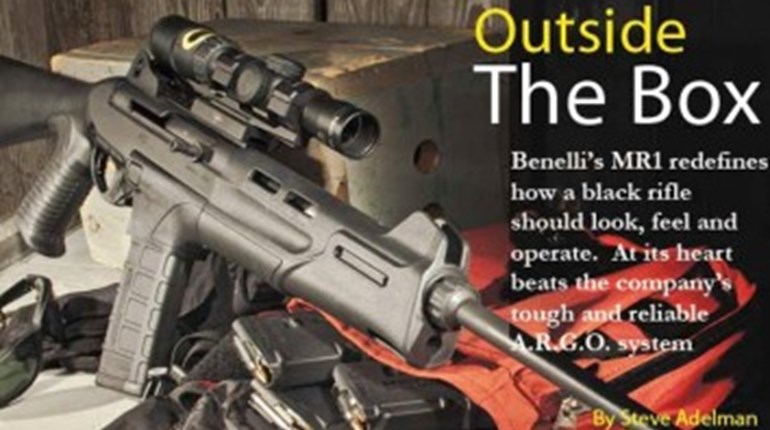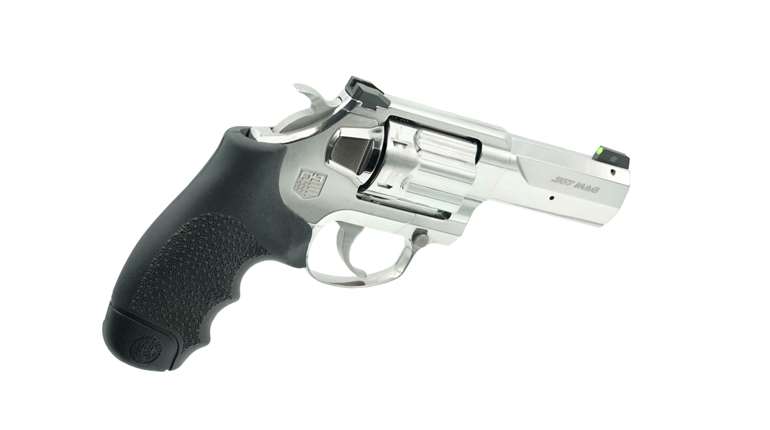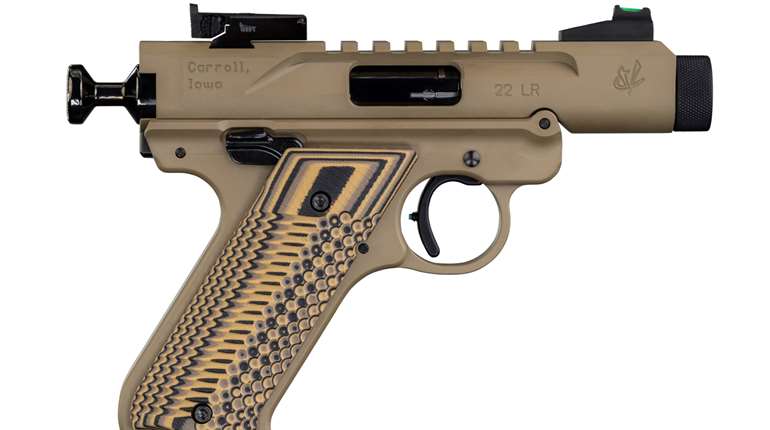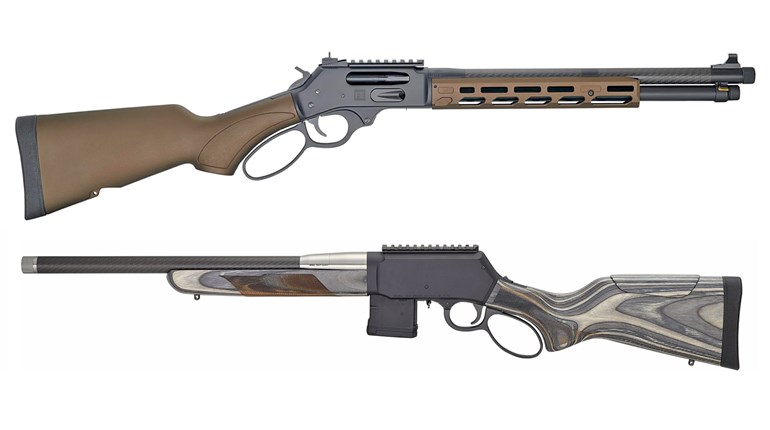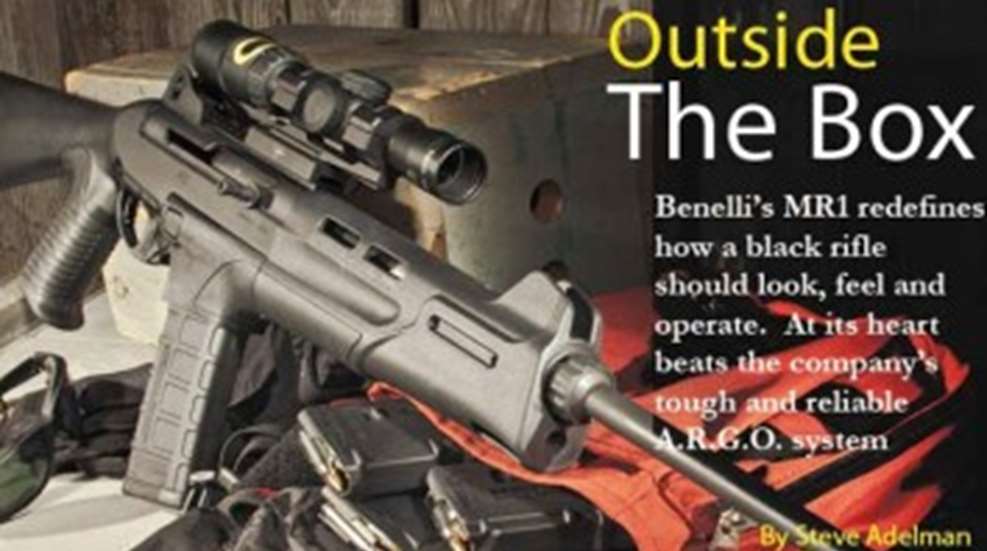
Since firearms began appearing on fields of battle, military versions have made the transition to civilian life with varying degrees of success. In most cases, a long arm is re-birthed with the changes necessary for civilian-legal sale and the story ends there. However, when the base platform is wildly successful on the commercial market (the AR being the best recent example) ergonomics and functionality both evolve to make it more attractive.
Sometimes the reverse is true, with a firearm starting life in civilian form and adapted to military pursuits. An early example was seen in the accurate flintlock rifles pressed into service by militia troops of the American Revolution. While we've seen periodic crossovers such as AR- and AK-platform conversions to shotgun and pistol configurations, in most cases the parent arm and its derivatives remain in the same rifle, pistol or shotgun class.
With the introduction of the MR1, Benelli has thrown all of the above ideas into one big pot and given it a good stirring. The company has blended a popular commercial shotgun design with a successful U.S. military service record and used it as the basis for a new commercial rifle. The carbine is chambered in 5.56 NATO and aims squarely at the booming defensive-firearm market. Given the way the AR has solidified the 5.56 carbine's place as the modern equivalent to our forefathers' hearth-hangers, no imagination is needed to see why Benelli chose this chambering.
Stripping away the marketing strategy reveals the heart of the MR1: the Adjustable Gas Regulated Operating (A.R.G.O.) piston system, which currently drives the Marine Corps' combat-proven M1014 (Benelli M4) shotgun. Benelli's literature declares the MR1 as "...the best home defense rifle available." As far as having a gun that will function reliably when needed most, it works as designed.
From the generous recoil pad to the unthreaded muzzle, the MR1 feels more like a shotgun than modern sporting rifle. The arrangement of the fixed stock and rubber pistol grip will both be familiar to tactical scatter-gunners. The upper receiver's traditional rise terminates at a robust and ruggedly protected rear peep sight, adjustable for windage and elevation via a pair of slotted screws. The pre-installed small aperture appears to roughly replicate the M16 family's small peep sight. A larger, replaceable aperture is included with each MR1, providing an option for close-range shooting. Swapping apertures requires removal of the windage screw, aperture and tension spring. The spring is then inserted into the well of the desired aperture and the process reversed. This isn't a quick or convenient swap intended for the field, but having an option for different needs is a plus.
Immediately forward of the rear sight, a 5-inch section of accessory rail is screwed to the top of the receiver. This short rail section and the high rear-sight housing make mounting a magnified optic quite a challenge. The rail is long enough for most scope-ring sets, but an additional riser base is required to allow the average scope's ocular bell to clear the rear sight. Raising the scope this high made a proper cheek weld difficult to maintain while moving the scope forward created too much eye relief for consistent groups. A long-eye-relief scope can be mounted if a forward extension rail is added to the Picatinny rail already present. I had planned to remove the rear sight completely in order to gain the needed clearance for normal scope mounting height, but its torx screws were solidly secured with a thread-locking compound. In the end, I opted for a very high scope mount and taped a pad to the stock for a field-expedient cheek rest.
Fire controls will be familiar to most semi-automatic shotgunners. Unfortunately for lefties and tactical shooters who practice weak-hand shooting, a non-reversible crossbolt safety is used. As a southpaw, I've come to the conclusion there is simply no efficient way to move this type of selector from safe to fire quickly. Conversely, the bolt lock is nicely ambidextrous and positioned on the front edge of the trigger guard, but my nubby trigger finger wasn't long enough to manipulate it. I found the best method to lock and release the bolt was to maintain my firing grip and use my support hand on the lever.
The magazine release is a very functional ambidextrous design and mag lockup was good. The release features a protected button on each side of the magazine well with a gripping surface molded in.
The charging handle is a long (7⁄8 inch), right-side-mounted knob fixed to the bolt carrier. It reciprocates with each shot, which is bad news because it can cause problems in close-quarters situations where barriers, gear or even the support hand can get induce stoppages. The good news is this knob provides a means to assist the bolt in the event it gets hung up on its trek into battery without need of a separate forward-assist assembly.
Finishing out the MR1's shooter interface is the fore-end. It's a removable polymer sleeve that fits over the barrel, piston and gas regulator and serves its purpose as a non-freefloated gripping surface. The bottom front of the handguard has a slight lip that helps anchor the fore-end when using a soft rest and also provides a comfortable off-hand grip stop.
A bi-directional sling slot is molded into the fore-end, which pairs with a two-sided, steel rear-sling attachment inserted through the buttstock. The only accessory option currently shown on Benelli's website is a tri-rail fore-end attachment that provides space for accessory mounting at the 3-, 6- and 9-o'clock positions. I didn't have one for my testing, but they appear to mount directly to the existing handguard, permitting use of lights, lasers, fore-grips or bipods. Rails will be a welcome option for anyone pressing the MR1 into a home-protection role. The owner's manual teases with depictions of a collapsible stock. Unfortunately, the MR1 is imported and therefore this AR-styled stock is not an option in the U.S. The fixed front sight consists of a sturdy steel blade, protected by high polymer ears on both sides and nested within the removable handguard.
Shooting Impressions
The MR1 I tested arrived disassembled to its major components. The owner's manual is a bit light on clarity of assembly guidance, but eventually I proved that even a simpleton can follow pictorial instructions. Once assembled and bearing optics, a trip to the range revealed the MR1's strengths and weaknesses.
One of the A.R.G.O. system's benefits is it lacks much of the complicated linkage of most other piston designs. The result is a light operating system up front, which is good for mitigating support-arm fatigue, but bad for recoil control. Despite the fixed stock length and average weight, the MR1 feels very portable. However, when firing from an aggressive standing position, the lack of a muzzle brake is noticeable. The piston system's cycling is perceptibly smooth, but I found it harder to follow through my shots and return to target than with 16-inch guns with muzzle brakes.
I was surprised to find the opposite to be the case when firing prone. Follow-through shots were actually much smoother than when standing—beyond what I normally see when comparing 5.56 NATO carbines in these positions. The bad news when prone is that comfortable use of a magnified optic is very difficult. While I frequently test open-sighted slug guns from the prone position before each hunting season, shotgun lines just don't lend themselves well to belly shooting with a riflescope. After firing for accuracy, I simply switched to a more appropriate reflex sight and the comfortably placed iron sights. I had no further issues.
Above all else, an effective firearm must go bang when you pull the trigger. My testing of the MR1 leaves me with the impression it easily passes that critical test. The handy carbine didn't turn in any whopper groups, but it did digest all 305 rounds of multiple factory loads I sent through it with zero malfunctions. Accuracy results show the MR1 wasn't built for tack-driving competitions, but instead place it solidly in the general-purpose shooter category.
My testing highlighted the fact that a firearm can love one type of ammo and hate another similar load. Black Hills Ammunition's excellent 55-grain TSX load fared best overall and is a solid choice for defensive use. At first glance, the trigger appears to be straight from Benelli's smoothbore line, but it's actually an adaptation of its R1 two-stage setup. The short first stage and slightly gritty second stage were consistently easy to control, and far better than any stock AR trigger I've fired.
The MR1 accepts STANAG magazines in addition to its supplied flush-fitting, five-round, steel mag. I tried a variety of aluminum and polymer 30-round magazines and had no lock-up, feeding or bolt hold-open issues. Due to the buttstock's large footprint, the toe prevents the MR1 from being rested on a 30-round AR magazine base-plate for hasty support. Either a bipod or rest will be needed for any supported shooting from the ground.
Benelli literature describes the A.R.G.O. system as cleaner burning, due in part to the placement of the gas port just in front of the chamber. This position drives hotter gases through the regulator, theoretically providing a self-cleaning element to the cycle of operation. While the actual gas piston and regulator were cleaner than those on other piston-driven systems I have used, the receivers and chamber were more heavily fouled than I'm used to seeing on 5.56 NATO semi-autos. The bulk of this funk was comprised of light carbon and oily gunk, both easily removed with a rag.
The bolt has Benelli's usual three mammoth locking lugs and appears to be made of stainless steel. This assembly was only lightly fouled and easily wiped clean. There was no carbon scraping required on any of the components.
Paying attention to a semi-auto rifle's placement of empties will tell you a lot about the operating system's consistency. The MR1 I tested blew my theories about reading brass patterns to pieces. While standing in the same position, firing at the same target, brass was arrayed along an elliptical pattern that measured 12 feet long by 6 feet wide. The brass was ejected randomly, and it flew all over the pattern. Benelli informed me this was not related to the A.R.G.O. system, which was my best guess. Erratic operating system timing is usually detrimental to accuracy and may indeed be the cause for the MR1's mediocre downrange performance. The brass showed no evidence of pressure changes or damage, so this one left me scratching my bald head.
Conclusions
The MR1 will appeal to fans of the A.R.G.O. system—shooters wanting a handy carbine with unyielding reliability. While its price tag tips the scales for a no-frills 5.56 NATO carbine, this gun is solidly designed to perform the ranch-rifle role effectively. More importantly, it inspires confidence that it's going to deliver shots on predators whenever called upon.












